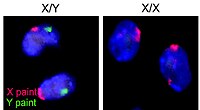
Photo from wikipedia
This study investigated the interactions between cumulus cells (CCs) and oocytes and programmed cell death in bovine cumulus-oocyte complexes (COCs) with different morphological characteristics. DNA fragmentation was assessed in CCs… Click to show full abstract
This study investigated the interactions between cumulus cells (CCs) and oocytes and programmed cell death in bovine cumulus-oocyte complexes (COCs) with different morphological characteristics. DNA fragmentation was assessed in CCs at 0 and 24 h of maturation, as well as parthenogenetic developmental competence on the 9th day post-activation, blastocyst quality and BCL-2 and BAX transcript levels in matured CCs. Most immature oocytes in the COC-A group (full cumulus and several compact layers) were in the initial germinal vesicle (iGV) stage, exhibiting minimal or no DNA damage. In contrast, after follicle removal, the COCB (partial cumulus and one or two cell layers) and C (expanded cumulus) groups presented in more advanced GV stages and exhibited DNA fragmentation. After maturation, significant increases in fragmented nuclei were noted in COCC and COCB groups. Embryos resulting from the COC-A developed more rapidly and had increased competence compared to embryos resulting from groups COCB and COCC. The COCB group exhibited the highest BAX protein levels and a reduced BCL-2/BAX protein ratio. The results show a negative correlation between nuclear fragmentation and embryonic development potential in COCs with different morphologies. In addition, a low BCL-2/BAX protein ratio might be associated with an increase in nuclear fragmentation in CCs.
Journal Title: Theriogenology
Year Published: 2019
Link to full text (if available)
Share on Social Media: Sign Up to like & get
recommendations!